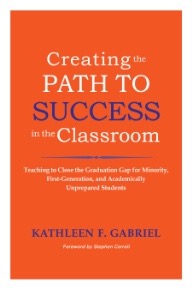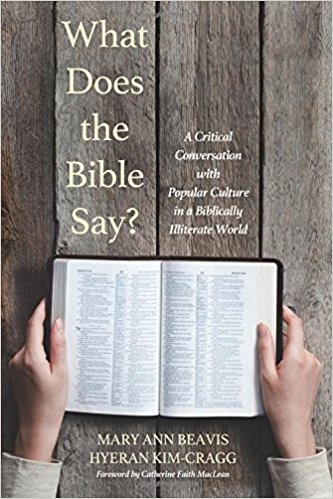student learning
Select an item by clicking its checkbox
I have a confession to make. For the longest time I have approached distance learning as the second best way to teach. I thought of it as a necessary evil in order to deliver theological education to those who could not receive instruction through the traditional face-to-face (hence F2F) ...
Date Reviewed: June 16, 2021
In a recent study, my research group at Harding University explored how a person’s learning context and personal experiences contribute to learning in an online course (Westbrook, McGaughy, and McDonald, 2018). The analysis highlighted the importance of experience as a resource for learning. In his book Nothing Never Happens, John ...

Creating the Path to Success in the Classroom: Teaching to Close the Graduation Gap for Minority, First-Generation, and Academically Unprepared Students
Date Reviewed: October 8, 2018
Kathleen Gabriel’s Creating the Path to Success in the Classroom is a clear, engaging, and practical book that will be of use to anyone teaching in a university or community-college classroom.
In his forward to the book, Stephen Caroll praises Gabriel’s “deep integration of theory and practice” (xiii). This integration is one of the book’s major strengths. Gabriel introduces the reader to scholarship on barriers to student learning, student mindsets, and effective pedagogy. Extensively referenced and cited, Gabriel’s book is thus a primer on classic and more recent scholarship of teaching and learning. After describing this scholarship, Gabriel then offers practical suggestions of classroom strategies designed to engage students effectively given the data. These range from one-time strategies – reading a particular article on growth mindsets as a class, doing an active-learning activity – to strategies that unfold over the course of an entire semester. Gabriel offers concrete scripts for welcoming students and setting a classroom tone, giving student feedback that encourages persistence and growth, creating and shuffling small groups, and much more. Gabriel not only suggests what to do and why, but also encourages faculty to make those reasons explicit to students, making students intentional partners in their own learning.
Gabriel explores strategies for creating a positive classroom climate during the first days of class, engaging students during the first month of the semester, growth mindsets and mental toughness, creating interactive lectures, motivating students to read, think about, and discuss course readings, integrating critical thinking and writing into class activities and assignments, and developing student resilience and persistence. In four appendices, Gabriel offers even more practical suggestions. For example, in her chapter on classroom climate, Gabriel notes that “one way that professors can increase their own cultural competence is to read both nonfiction and fiction material that addresses multicultural issues” (20). Gabriel then directs the reader to Appendix A, a list of nonfiction and fiction readings by authors of color that helped her expand her own “cultural competence and awareness” (131).
Gabriel is gentle in encouraging faculty to teach minority, first-generation, and academically unprepared students more effectively, suggesting incremental steps that faculty can take as they become more comfortable with new pedagogical strategies. She insists throughout that inclusive pedagogy not come at the expense of a rigorous academic standards: “We can design our assignments in a way that holds students to high standards, but, at the same time, we can give all our students encouragement, support, and resources so that they have ample opportunity to achieve those standards” (111).
Creating the Path to Success in the Classroom will be helpful to teaching veterans and novices alike. In her opening chapter, Gabriel frames the book as designed to help faculty effectively teach and retain minority, first-generation, and academically unprepared students. As is the case with many implementations of universal design principles, however, these strategies ultimately improve student engagement and learning for all students.

What Does the Bible Say? A Critical Conversation with Popular Culture in a Biblically Illiterate World
Date Reviewed: October 4, 2018
Mary Ann Beavis and Hyeran Kim-Cragg, a biblical scholar and a practical theologian, respectively, address a number of topics that are engaged by people outside of the contours of usual religious contexts; those who tacitly or consciously engage with scriptural and religious themes. It is this audience that the authors seem in particular to target: the everyday person whose religious viewpoints are influenced by media and popular culture, without their realizing the underlying misconceptions borne of poor theologies, or uncritical appropriation of traditions with little or no basis either on sound doctrine or biblical knowledge. In juxtaposing biblical themes such as creation and apocalypse, sin and salvation, Moses and Jesus, Jews and Christians, God and Satan, Christ and Antichrist, gender and God, purity and sex, and suffering and sacrifice, in a creative dialogue with cinematic culture, the authors seek to dispel many of these aforementioned misconceptions.
Beavis and Kim-Cragg have succeeded in making scholarly information accessible, taking pains to define technical terms – whether Hebrew, Greek, or theological jargon – that would otherwise be foreign to nonexperts. They provide solid exegetical and theological analysis of the themes they have chosen. Readers and teachers will find the creative way in which they use movies from a wide array of genres to further their discussion helpful. “Before viewing” and “after viewing” questions allow one to link their cinematic selections with the theological theme under discussion. This is especially helpful since, for the most part, the authors did not choose religious movies; it is, after all, an engagement with popular culture, not religious media.
As a professor of constructive theology, I especially appreciate the discussion of salvation in chapter 2, subtly broadening its meaning by disconnecting it from the notion of sin and at least implicitly relating it to the Reign of God, and their discussion of eschatology in chapter 5, rightly linking it with relationship. Another discussion which I found to be of importance in this time of intolerance and rising tides of anti-Semitic, anti-Muslim, and nativistic impulses, was their discussion on Jews and Christians (chapter 4). While their assertation that “Jesus was a Jew” might seem simplistic, I can attest to the fact that such a statement can be a surprise to some beginning seminary students. Beavis and Kim-Cragg honestly tackle texts in Second Testament that have been interpreted as “anti-Jewish” as well as the history of anti-Semitic interpretations in Christian theology. It is their conclusion that in spite of this persistent prejudice, we stand well to remember that “God blesses all” (62).
For teachers in the areas of practical theology, this book can be used in courses that integrate biblical studies with Christian education, theology, or preaching. The authors’ approach to theological themes can prove helpful to beginning seminary students who come with popular misconceptions, only to become disconcerted by learning in the classroom what they believe to be contradictions of faith. The book’s methodology of integrating theological content with media is insightful and consonant with the contemporary world in which our students live and practice ministry. It is particularly useful as teachers become aware of the various learning styles of students and expands their arsenal of creative pedagogical practices. I would hope that this book invites teachers to consider the use of movies, music, photography, and online content such as TED talks in their classroom. This book is a good companion to such sources as Timothy B. Cargal’s, Hearing a Film, Seeing a Sermon, although the latter tends to focus more on homiletical and liturgical integration.
I do have some questions. While I assume that the audience for this book is either a lay or church community, the authors themselves never clearly identify their audience: is this meant for a more evangelical or progressive church community, or was it directed primarily to an unchurched community? I would have found it helpful for the authors to have been more explicit about their audience. This leads to a second question: why their particular juxtaposition of selected themes? Was it influenced by context and audience? For example, why discuss God and gender, and not God and justice? Would the latter not have allowed the discussion to be broader than simply whether our God-talk is inclusive in terms of male or female images? At a time of imposition of heteronormativity, homophobia, and rising tide of violence against people of color, it could have led to larger questions about white privilege, and broader assumptions about gender could have been broached. Along those lines, could the discussion have been further enriched with the inclusion of more voices of color, both in the authors’ scholarly sources and in their movie choices? Could some of these very themes have been underscored with such movies as Hidden Stories, The Color Purple, Selma, Even the Rain, The Joy Luck Club, or others that showcase actors of color or LGBTQI persons?
These questions, of course, do not detract from the overall importance and value of the book. This book, with its solid theological and biblical analyses, is an important resource particularly for those of us who continuously encounter groups or individuals in our churches, classrooms, and communities that espouse uninformed biblical and theological beliefs influenced by popular culture.


